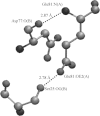Contributions of the interdomain loop, amino terminus, and subunit interface to the ligand-facilitated dimerization of neurophysin: crystal structures and mutation studies of bovine neurophysin-I
- PMID: 17192588
- PMCID: PMC2222833
- DOI: 10.1110/ps.062444807
Contributions of the interdomain loop, amino terminus, and subunit interface to the ligand-facilitated dimerization of neurophysin: crystal structures and mutation studies of bovine neurophysin-I
Abstract
Current evidence indicates that the ligand-facilitated dimerization of neurophysin is mediated in part by dimerization-induced changes at the hormone binding site of the unliganded state that increase ligand affinity. To elucidate other contributory factors, we investigated the potential role of neurophysin's short interdomain loop (residues 55-59), particularly the effects of loop residue mutation and of deleting amino-terminal residues 1-6, which interact with the loop and adjacent residues 53-54. The neurophysin studied was bovine neurophysin-I, necessitating determination of the crystal structures of des 1-6 bovine neurophysin-I in unliganded and liganded dimeric states, as well as the structure of its liganded Q58V mutant, in which peptide was bound with unexpectedly increased affinity. Increases in dimerization constant associated with selected loop residue mutations and with deletion of residues 1-6, together with structural data, provided evidence that dimerization of unliganded neurophysin-I is constrained by hydrogen bonding of the side chains of Gln58, Ser56, and Gln55 and by amino terminus interactions, loss or alteration of these hydrogen bonds, and probable loss of amino terminus interactions, contributing to the increased dimerization of the liganded state. An additional intersubunit hydrogen bond from residue 81, present only in the liganded state, was demonstrated as the largest single effect of ligand binding directly on the subunit interface. Comparison of bovine neurophysins I and II indicates broadly similar mechanisms for both, with the exception in neurophysin II of the absence of Gln55 side chain hydrogen bonds in the unliganded state and a more firmly established loss of amino terminus interactions in the liganded state. Evidence is presented that loop status modulates dimerization via long-range effects on neurophysin conformation involving neighboring Phe22 as a key intermediary.
Figures


 <0.5 for the double mutant as described in Materials and Methods, which, in this case, would not have significantly influenced the calculated binding constant.
<0.5 for the double mutant as described in Materials and Methods, which, in this case, would not have significantly influenced the calculated binding constant.








Similar articles
-
NMR analysis of the monomeric form of a mutant unliganded bovine neurophysin: comparison with the crystal structure of a neurophysin dimer.Biochemistry. 2002 May 7;41(18):5920-30. doi: 10.1021/bi012067k. Biochemistry. 2002. PMID: 11980496
-
NMR investigation of main-chain dynamics of the H80E mutant of bovine neurophysin-I: demonstration of dimerization-induced changes at the hormone-binding site.Biochemistry. 2005 Sep 6;44(35):11766-76. doi: 10.1021/bi0504153. Biochemistry. 2005. PMID: 16128578
-
The behavior of the active site salt bridge of bovine neurophysins as monitored by 15N NMR spectroscopy and chemical substitution. Relationship to biochemical properties.Biochemistry. 1996 Sep 10;35(36):11763-72. doi: 10.1021/bi960906a. Biochemistry. 1996. PMID: 8794757
-
Elucidation of neurophysin/bioligand interactions from molecular modeling.Acta Biochim Pol. 1997;44(3):453-66. Acta Biochim Pol. 1997. PMID: 9511957 Review.
-
Structures of a hemoglobin-based blood substitute: insights into the function of allosteric proteins.Structure. 1997 Feb 15;5(2):227-37. doi: 10.1016/s0969-2126(97)00181-0. Structure. 1997. PMID: 9032082 Review.
Cited by
-
Crystal structure of barley agmatine coumaroyltransferase, an N-acyltransferase from the BAHD superfamily.Acta Crystallogr F Struct Biol Commun. 2020 Dec 1;76(Pt 12):590-596. doi: 10.1107/S2053230X20014880. Epub 2020 Nov 25. Acta Crystallogr F Struct Biol Commun. 2020. PMID: 33263570 Free PMC article.
References
-
- Barat, C., Simpson, L.-R., and Breslow, E. 2004. Properties of human vasopressin constructs: Inefficient monomer folding in the absence of copeptin as a potential contributor to diabetes insipidus. Biochemistry 43 8191–8203. - PubMed
-
- Breslow, E. and Burman, S. 1990. Molecular, thermodynamic and biological aspects of recognition and function in neurophysin-hormone systems: A model system for the analysis of protein–peptide interactions. Adv. Enzymol 63 1–67. - PubMed
-
- Breslow, E., Weis, J., and Menendez-Botet, C.J. 1973. Small peptides as analogs of oxytocin and vasopressin in their interactions with bovine neurophysin-II. Biochemistry 12 4644–4653. - PubMed
-
- Breslow, E., LaBorde, T., Bamezai, S., and Scarlata, S. 1991. Binding and fluorescence studies of the relationship between neurophysin–peptide interaction and neurophysin self-association: An allosteric system exhibiting minimal cooperativity. Biochemistry 30 7990–8000. - PubMed
-
- Breslow, E., Mishra, P.K., Huang, H.-B., and Bothner-by, A. 1992. Slowly interchanging conformers of bovine neurophysin-II in the unliganded dimeric state. Biochemistry 31 11397–11404. - PubMed
Publication types
MeSH terms
Substances
Associated data
- Actions
- Actions
- Actions
Grants and funding
LinkOut - more resources
Full Text Sources

